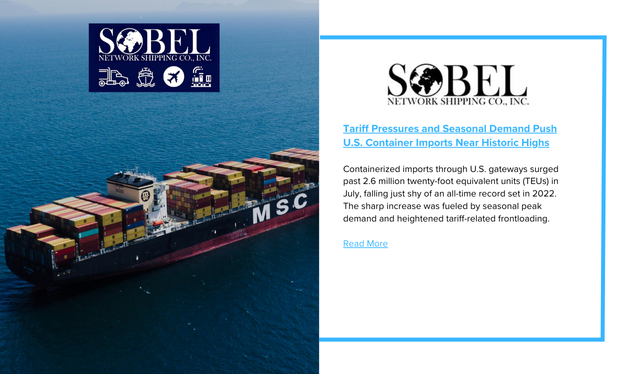Containerized imports through U.S. gateways surged past 2.6 million twenty-foot equivalent units (TEUs) in July, falling just shy of an all-time record set in 2022. The sharp increase was fueled by seasonal peak demand and heightened tariff-related frontloading.
According to industry data, volumes reached 2,621,910 TEUs — an 18.2% rise from June and a 2.6% increase over July last year. The growth was accompanied by only mild congestion, suggesting port infrastructure continues to handle elevated throughput effectively.
Imports from Asia rebounded strongly, with volumes climbing more than 40% month-over-month, marking the highest level since early 2024. This lifted Asia’s share of U.S. imports to over one-third of all shipments, though still below pre-pandemic highs.
The acceleration comes against a backdrop of shifting trade policy. Recent tariff hikes now cover dozens of global trade partners, with rates ranging from 10% to 41% and special levies on certain commodities. For U.S. importers, this has created strong incentives to advance shipments before deadlines, reshaping seasonal trade flows.
Regional performance was broadly positive, with East, West, and Gulf Coast ports all reporting double-digit growth. Miami and Houston recorded the strongest monthly gains, followed by notable increases at Oakland, Savannah, and other major gateways.
Product categories showing the largest growth included furniture and bedding, plastics, and machinery, with additional momentum from consumer goods such as toys, electronics, and vehicles. Analysts noted that long-term sourcing shifts remain underway, as higher tariffs on alternative sourcing hubs like Vietnam complicate diversification efforts.
While July volumes underscored the resilience of U.S. consumer demand and global sourcing networks, uncertainties remain. Analysts caution that elevated tariffs, stricter customs enforcement, and potential penalties on transshipments may dampen growth later this year.
For now, July’s surge highlights both the adaptability of supply chains under pressure and the continuing influence of tariff policy on global trade flows.


